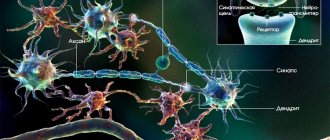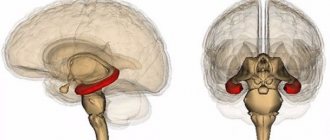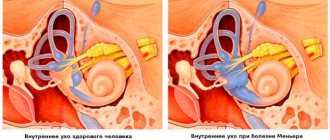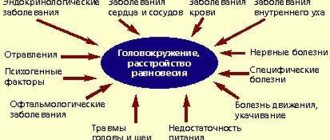The head is a dark object, but subject to research. What is responsible for what in the brain?
The ability to breathe and move, feel pain and love, create brilliant creations and commit evil, sometimes beyond explanation. What makes all this possible? Where is our “I” hidden?
We seem to know a lot about the brain. And we don’t just know, we can control it. Pedagogy and psychology, neurology and psychiatry are the areas of knowledge that confirm this.
How does the human brain work, how do its structure and functions relate, and what are their features?
Let's try to understand some of them.
The simpler the more accurate
There is a position that the simpler a certain function, the more precise the location of its localization in the brain. On the other hand, the most complex functions are ensured by the coordinated work of the entire brain, and therefore the concept of a “cortical center” (a certain area of the cerebral cortex) is mostly relative and conditional.
From simple to complex
Sneezing, coughing, breathing, heart rate, blood pressure and the functioning of the digestive system are possible due to the presence of the medulla oblongata, a part of the nervous system directly connected to the spinal cord.
Did a dog suddenly bark in the yard? The orienting reflex in response to a sharp sound is possible thanks to the midbrain. In addition, through this region pass pathways that provide vision, hearing, the ability to move and vigilance, temperature control, and a number of others that are involved in other parts of the brain.
Read material on the topic: Leader of relativity Albert Einstein: how did the brain of a genius work?
Do you want to drink or eat? The hypothalamus, part of the diencephalon, is responsible for these feelings. It is also associated with such physiological functions as sleep and wakefulness, maintaining the constancy of the internal environment of the body.
THE CORTEX OF THE LARGE HEMISPHERES HAS A COMPLEX STRUCTURE AND CONTAINS 12-18 BILLION NERVE CELLS AND IS DIVIDED BY FROWS INTO SEVERAL LOBE
Now close your eyes and touch the tip of your nose with your fingers. It turned out without much difficulty, didn’t it? This is despite the fact that many different muscles were involved in this smooth action. Thanks to the cerebellum for coordination, balance, and normal movements.
Harder, harder
Emotions, such emotions... Without them, our life would not be so happy (unhappy?). An internal struggle that sometimes forces us to do things that we will later regret. Sound familiar? Thank you limbic system. I wonder what it is? A little more about it (and its parts).
Worried, sad? Or maybe you're scared? This is possible thanks to the amygdala (amygdala). An interesting fact: a feeling of happiness is also associated with the left amygdala, but the right amygdala is always in a bad “mood”.
Read the material on the topic: Bill Gates and his Asperger's syndrome
Do you remember the direction of movement? The hippocampus, another part of the limbic system, helps with this.
The conductor of sensory information - the thalamus - receives information from the senses, forwarding it for further processing to the cerebral cortex. Are you sleeping and don’t hear sounds, are you not affected by light? This is because the thalamus “sleeps” with you. But olfactory sensations can easily enter the sleeping thalamus. The sense of smell interacts closely with the amygdala and hippocampus. Therefore, smell is associated with memory and emotions.
And finally...
Gradually becoming more complex in the process of evolutionary development, the brain acquired a part known as the cerebral hemispheres, covered with a kind of “cloak” - the cerebral cortex. It has a complex structure and contains 12-18 billion nerve cells and is divided into several lobes by grooves.
So what is her role?
Thinking is associated with the frontal lobe. The front part of it, the so-called prefrontal cortex, is most involved in thinking. “You need to work”, “Don’t think about what others think of you.” The “rational” prefrontal cortex helps us with this.
Read the material on the topic: What happens to the brain of autistic people?
Our ability to move (thanks to the motor cortex), write clearly and legibly, and articulate is also associated with the frontal lobe.
Associative functions are provided by the parietal lobe of the cortex. Here are the areas responsible for touch, clear, combined purposeful movements, reading, cognition of objects, phenomena, their meaning and symbolic meaning.
Memory and the ability to hear - we have these capabilities thanks to the temporal lobe. Here is the center of oral speech, which allows us to speak beautifully and correctly, the centers of taste analyzers.
We can see thanks to the occipital lobe of the cerebral cortex, and we can count thanks to the center located at the junction of the parieto-occipital region.
It is striking that...
... a certain function does not always have one localization in the human brain. This is especially true for complex functions. For example, the so-called praxis - the ability to carry out purposeful motor acts - is possible thanks to a system involving the parietal and frontal lobes.
Read the material on the topic: What to do if cerebral gliosis is detected?
The most complex functions of memory and thinking do not have a clear location; various areas of the brain take part in their implementation.
Why is it important to know how brain function and structure are related?
Diagnostics. Imagine: a person has a severe headache. After a few minutes, he was no longer able to raise his right arm, and his speech became slurred. The patient's vision deteriorated on one side, while the ophthalmologist did not find pathology on the part of the eyes. Or, for example, a person has ceased to understand speech addressed to him.
Read the material on the topic: How to prevent a stroke?
Knowing which parts of the brain are responsible for a particular ability, we can guess the location of the pathological process.
Treatment and rehabilitation. Suppose that as a result of damage to a part of the brain after a stroke, a person “lost” some function. Does this mean she won't come back now? No, not always.
Read the material on the topic: What is the difference between ischemic and hemorrhagic stroke?
Thanks to such a property of the brain as plasticity, it is possible to restore this function. In simple terms, plasticity can be understood as the ability of other areas of the brain to take over the function of the damaged part. However, this process needs to be addressed purposefully. Therefore, after a stroke, a patient may need a course of neurorehabilitation, during which he re-learns to speak, walk, and care for himself.
Is everything ingenious simple?
No. The above descriptions of the relationship between structure and function are far from exhaustive: in reality, everything is much more complex and goes far beyond the scope of a short article.
Well, where is our “I”? Science has yet to answer this question. Isn't this a case where the whole is more than the sum of its parts?
Other materials on topics:
What is hidden behind the diagnosis of migraine?
"Cast iron head" How to alleviate your condition?
Vegetative-vascular dystonia - what is it - a diagnosis or a fiction?
General information about the brain
The brain is made up of more than 100 billion nerve cells. The structure of the organ is anatomically divided into the cerebrum, which consists of the right and left hemispheres, the cerebellum and the brain stem. The brain is covered with 3 membranes and occupies up to 95% of the capacity of the cranium.
Infographics: structure of the human brain
The mass of brain tissue in healthy people varies and on average is in the range of 1100-1800 grams. No connection has been established between human abilities and brain weight. In women, as a rule, the central organ of the NS weighs 200 grams less than in men.
The brain is covered with gray matter - the main functional sphere, where the bodies of almost all neurons are located, which form the cerebral cortex. Inside there is white matter, which consists of processes of neurons and represents the pathways along which information enters the cortex for analysis and, after this, commands are transmitted down.
Not only are there control centers in the cerebral cortex, which are called screen centers, they are also present deep in the brain, surrounded by white matter. Such centers are called nuclear or subcortical (clusters of nerve cell bodies in the form of nuclei).
Inside the brain there is a hollow system, which consists of 4 ventricles and several ducts. It connects to the spinal cord canal. Within this system, cerebrospinal fluid, or cerebrospinal fluid, circulates, which performs a protective function.
Brain functions
The brain has a very complex structure, which corresponds to the functions it performs. It is very difficult to list them, since this includes the entire sphere of activity of the human body. Let's dwell on the basic functions of life:
- Physical activity . All movements of the body are associated with the activity of the area of the cerebral cortex, which is located in the parietal lobe in the central anterior gyrus. The activity of all skeletal muscle groups is under the direction of this part of the brain.
- Sensitivity. The central posterior gyrus in the parietal lobe of the cerebral cortex is responsible for this function. In addition to skin sensitivity (tactile, pain, temperature, baroreceptor), there is also a center of proprioceptive sensitivity, which controls the sense of the position of the body and its individual parts in space.
- Rumor . The area of the brain that is responsible for hearing is located in the temporal lobes of the cortex.
- Vision. The visual center is localized in the occipital region of the cortex.
- Taste and smell . The center that is responsible for these functions can be found on the border of the frontal and temporal lobes, in the gyri.
- Human speech , both motor function and sensory (pronunciation of words and their understanding) are located in the Broca's and Wernicke's centers of the cerebral hemispheres.
- In the medulla oblongata there are all centers important for life - breathing, heartbeat, regulation of the lumen of blood vessels, food reflexes, for example, swallowing, all protective reflexes (coughing, sneezing, gagging, lacrimation, etc.), regulation of the state of smooth muscle fibers of internal organs.
- The posterior part of the organ regulates the maintenance of balance and coordination of motor activity, in addition, there are many pathways that carry information to the higher and lower centers of the brain.
- The midbrain contains subcortical centers that regulate visual, auditory and motor functions at the lower level.
- Diencephalon : the thalamus regulates all types of sensitivity, and the hypothalamus converts nerve signals into endocrine signals (the central organ of the human endocrine system), and also regulates the activity of the autonomic nervous system.
These are the main centers of the brain that provide a person with life, but there are many others, for example, the center of writing, counting, music, centers of human character, irritability, color differences, appetite, etc.
Main functional centers of the brain
Finite brain
This part has the largest volume (80%) compared to the rest. It consists of two cerebral hemispheres, the corpus callosum connecting them, and the olfactory center.
The large hemispheres of the brain, left and right, are responsible for the formation of all thought processes. Here there is the greatest concentration of neurons and the most complex connections between them are observed. In the depths of the longitudinal groove, which divides the hemispheres, there is a dense concentration of white matter - the corpus callosum. It consists of complex plexuses of nerve fibers that intertwine different parts of the nervous system.
Within the white matter are clusters of neurons called the basal ganglia. The close location to the “transport junction” of the brain allows these formations to regulate muscle tone and carry out instant reflex-motor reactions. In addition, the basal ganglia are responsible for the formation and operation of complex automatic actions, partially repeating the functions of the cerebellum.






